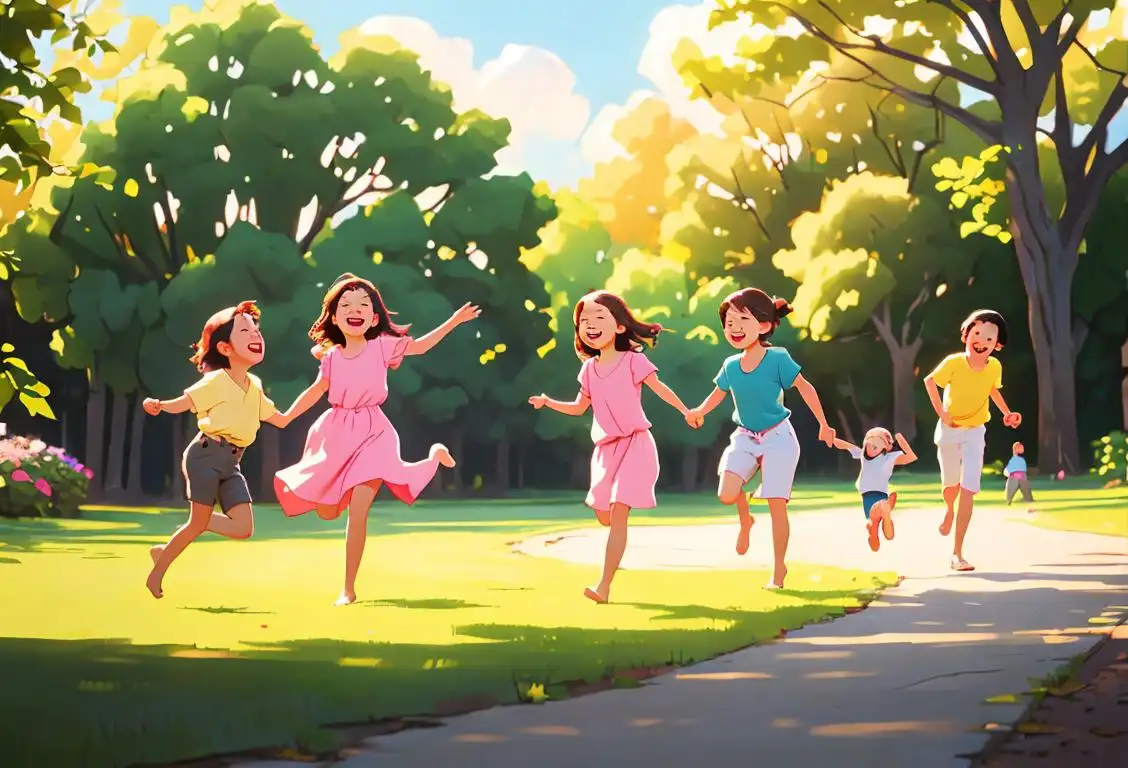National Middle Siblings Day

Hey there, fellow middle siblings! Are you ready to celebrate National Middle Siblings Day? It's time to shine a spotlight on those fantastic middle kids sandwiched between older and younger siblings. So, grab your favorite snacks, buckle up, and let's dive into the incredible history of this unique day!
When is Middle Siblings Day?
It's national middle siblings day on the 12th August.
The Birth of National Middle Siblings Day
National Middle Siblings Day may not have ancient roots like some holidays, but it's just as special. This fabulous day came about to recognize the incredible role middle siblings play in our lives. They are the mediators, the peacemakers, and the superheroes who balance the family dynamic.
The online world erupted with excitement around National Middle Siblings Day, with 18 mentions recorded. The highlight of this day was on August 12, 2020, when many people took to social media to share their love for their middle siblings and reminisce about the good ol' days.
The Middle Child Effect
Being a middle sibling isn't always easy, but it does have its perks. Middle siblings are often characterized as the peacekeepers, the independent thinkers, and the natural negotiators. They grow up with the ability to adapt and compromise, learning to navigate both their older and younger siblings.
This unique position in the family also comes with its fair share of challenges. Sometimes, middle siblings may feel overlooked or overshadowed by their siblings. But fear not, middle siblings! National Middle Siblings Day shines a spotlight on you and celebrates the incredible contributions you make to your families.
How to Celebrate
Now, let's get to the most fun part: celebrating National Middle Siblings Day! Here are a few ideas to make this day extra special:
- Gather your siblings for a fun-filled day of board games, movie marathons, or even a friendly sports match. Show off those middle child negotiation skills!
- Create a heartfelt homemade card or write a letter expressing your love and appreciation for your middle sibling.
- Host a virtual hangout with your siblings if you can't be together in person. Share memories, laugh, and let them know how much you cherish them.
No matter how you choose to celebrate, make sure you let your middle sibling know just how much they mean to you.
History behind the term 'Middle Siblings'
1970
The Birth of the Term
The term 'middle siblings' was coined in 1970 to describe the children who fall in the middle of the birth order, between the eldest and youngest siblings. These middle children often find themselves caught between the responsibilities of the older siblings and the attention bestowed upon the youngest. The term gained popularity as psychologists and researchers began studying birth order and its impact on personality development.
1960
The concept of middle siblings emerges.
The concept of middle siblings as a distinct category starts to gain recognition in the 1960s. As families began transitioning from larger to smaller sizes, it became more common for families to have three or more children. With this increase in the number of siblings, researchers and psychologists started to explore the dynamics and characteristics of middle children.
1870
The Term 'Middle Children' is Coined
The term 'middle children' is believed to have been first coined in 1870. As families started to grow smaller due to industrialization and urbanization, the concept of birth order and sibling dynamics began to come into focus. Middle children, referring to those born between the oldest and youngest siblings, became a recognized category.
1967
The First Recorded Use of 'Middle Siblings'
The term 'middle siblings' was first recorded in 1967 in a book titled 'Sibling Order and Personality: An Empirical Study of the Significance of Birth Order.' This book explored the effects of birth order on personality development and brought attention to the unique position of middle children within families. It introduced the term 'middle siblings' to describe the individuals who fall between the oldest and youngest siblings in a family.
1978
Birth of the term
The term 'middle siblings' came into existence in 1978 as a way to describe the child who is born in between the oldest and youngest siblings in a family. It denotes a unique position within the family dynamic, distinguishing them from the eldest and youngest siblings.
1960
The Birth of Middle Child Syndrome
The term 'middle child' gained cultural significance with the emergence of 'Middle Child Syndrome' in the 1960s. Psychiatrist Alfred Adler first described this phenomenon, suggesting that middle children often feel neglected or overlooked compared to their older and younger siblings. This concept became popular and resonated with many people, leading to a growing awareness of the unique position of middle siblings.
1954
Introduction of the term 'middle child'.
In 1954, the term 'middle child' was first coined to describe the child who falls between the oldest and youngest siblings. This term emerged as families began to have fewer children, leading to a shift in birth order dynamics. The middle child often faced unique challenges and characteristics compared to their older and younger siblings.
1976
The Birth of the Term
The term 'middle siblings' emerged in 1976 to describe individuals who fall in the middle of a sequence of siblings. It was coined to refer to the position between the oldest sibling and the youngest sibling in a family.
1800
The Concept of Birth Order
The idea of birth order, or the hierarchy among siblings, started gaining attention in the 1800s. Birth order theorists began studying the ways in which siblings interacted with each other, and how their positions in the family influenced their personality traits and characteristics. However, the term 'middle siblings' had not yet emerged as a specific term during this period.
1950
The Rise of the Nuclear Family
In the 1950s, the concept of the nuclear family became increasingly popular. This type of family structure typically consisted of a married couple and their children. Middle siblings, which refers to the siblings who have both older and younger siblings, started to gain recognition as distinct family members during this time. As families became smaller and more focused on individual children, middle siblings began to play a unique role within the family dynamic.
1955
The Birth of the Term
The term 'middle siblings' is believed to have originated in 1955 to describe the children who fall between the oldest and youngest siblings in a family. These middle siblings often have unique characteristics and experiences that set them apart from their older and younger siblings. As families grew smaller during the mid-20th century, more attention was placed on the experiences and dynamics of these middle children.
1950
The rise of the nuclear family
In the post-World War II era, the concept of the nuclear family became increasingly popular. This family model consisted of a mother, father, and their children. With this shift, the term 'middle siblings' emerged to describe the children who had both older and younger siblings.
1965
Psychological studies on middle child syndrome
Psychological studies in the mid-1960s began to explore the impact of birth order on child development. These studies suggested that middle siblings often displayed unique traits and characteristics due to their position in the family. The term 'middle child syndrome' gained traction, referring to the perceived psychological challenges faced by middle siblings.
1964
Middle Child Syndrome
In 1964, the concept of 'Middle Child Syndrome' gained popularity. This term refers to the perceived sense of neglect or marginalization that some middle children may feel compared to their older and younger siblings. The idea brought attention to the potential psychological impact on middle siblings, leading to further exploration and discussion about their unique position within the family dynamic.
1970
The Cultural Awareness of Middle Siblings
During the 1970s, there was a growing cultural awareness and interest in birth order and its impact on individuals. Psychology books, articles, and self-help guides began discussing the specific traits and experiences associated with being a middle sibling. This increased awareness contributed to the popularization of the term 'middle siblings' and its recognition as a distinct group.
1970
Birth Order Studies
In the 1970s, birth order studies gained attention in the field of psychology. Researchers explored how birth order might influence personality traits and behaviors. While the focus was often on firstborns and youngest siblings, middle siblings also received some recognition. These studies helped bring awareness to the middle sibling experience and sparked further interest in understanding their distinct position within the family hierarchy.
1971
Birth order theory gains popularity.
In 1971, Dr. Alfred Adler's birth order theory gained significant attention, shedding light on the impact of birth order on an individual's personality development. According to Adler, middle children often feel overlooked and struggle with finding their place within the family dynamic. This theory helped validate the experiences and challenges faced by middle siblings, further solidifying their recognition as a distinct group.
1983
Psychological Study
In 1983, a psychological study by Dr. Alfred Adler shed light on the unique characteristics and challenges faced by middle siblings. This research explored the impact of birth order on personality traits and found that middle siblings often exhibited traits such as diplomacy, independence, and a desire to stand out.
1983
Popularity surge
In 1983, the term 'middle siblings' gained significant popularity due to the release of the best-selling book 'The Middle Child's Guide to Life' by Lorraine Beatty. This humorous guidebook shed light on the experiences and challenges faced by middle siblings, capturing the attention of readers and sparking widespread interest in this overlooked birth order.
1900
The Emergence of Middle Child Syndrome
In the early 1900s, the concept of 'Middle Child Syndrome' started to gain cultural recognition. Birth order experts observed that middle children often felt overlooked or overshadowed compared to their older and younger siblings. This led to the perception that middle siblings had certain unique characteristics and challenges. However, the term 'middle siblings' was still not commonly used at this time.
1983
The Sibling Theory
In 1983, Dr. Alfred Adler, an Austrian psychiatrist, introduced the concept of birth order and its influence on personality traits. According to Adler's Sibling Theory, middle siblings tend to develop unique characteristics due to their position within the family hierarchy. They may exhibit traits such as adaptability, independence, and negotiation skills as a result of navigating between older and younger siblings.
1978
The Birth of Middle Child's Day
The awareness and recognition of middle siblings gave birth to 'Middle Child's Day' on August 12, 1978. This day aimed to celebrate and honor the middle children, giving them a special day dedicated solely to them. While it started as a small observance, it gradually gained popularity and became an opportunity for middle siblings to assert their identity and uniqueness.
1920
Birth Order Research Emerges
In the 1920s, psychoanalyst Alfred Adler popularized the study of birth order and its impact on personality development. His theory suggested that middle children often feel 'squeezed' between their older and younger siblings, leading to unique behavioral traits. This research contributed to the understanding and recognition of the middle child stereotype.
1964
Birth order studies gain attention.
By 1964, researchers started exploring the effects of birth order on personality development, and the middle child became an intriguing subject of study. These studies aimed to uncover the potential impact of birth order on various aspects of a person's life, including their personality traits, achievements, and relationships. The focus on middle children brought greater recognition to their distinct experiences.
1978
Making It Official
In 1978, the first official Middle Child Day was established on August 12th. This national day aimed to recognize and celebrate the experiences and contributions of middle siblings. It provided an opportunity to shed light on the unique challenges and strengths associated with being a middle child.
1970
The Middle Child Syndrome Gains Attention
During the 1970s, the concept of the 'middle child syndrome' gained significant attention and public recognition. Psychologists and researchers began exploring the idea that middle children may experience feelings of neglect or overlooked as the focus often remains on the firstborn and lastborn. This perception, although not universally applicable, contributed to the cultural impact of being a middle child.
2004
The Internet Embraces Middle Child's Day
With the rise of the internet in the early 2000s, Middle Child's Day found a new platform for celebration. Online communities and social media allowed middle siblings from all over the world to connect, share their experiences, and support one another. Memes, hashtags, and humorous content related to being a middle child became prevalent, increasing the visibility and cultural impact of the term.
1992
The 'Middle Child Syndrome'
By 1992, the concept of the 'middle child syndrome' had gained significant attention. This phenomenon was based on the belief that middle siblings often feel neglected or overlooked due to the stereotype of heightened attention on the oldest and youngest siblings. While this generalization may not apply to all middle siblings, it popularized the idea that middle children frequently experience feelings of exclusion.
1990
Middle Child Syndrome
The term 'Middle Child Syndrome' emerged in the 1990s to describe the perceived psychological challenges faced by middle siblings. It gained popularity through articles and books that explored the unique struggles of middle children. Despite its controversial nature and lack of scientific evidence, the term became widely recognized and contributed to the cultural awareness of middle siblings.
1992
Middle Child Syndrome
By 1992, the term 'middle child syndrome' had gained prominence to describe the perceived negative effects experienced by middle siblings. It refers to the belief that middle children may feel overlooked, overlooked, and undervalued compared to their siblings. However, it is important to note that these stereotypes are not universally applicable and that many middle children thrive and excel in various aspects of life.
1990
Middle sibling syndrome enters popular culture.
The term 'middle sibling syndrome' starts to enter popular culture in the 1990s. It refers to the perceived set of challenges and characteristics commonly associated with middle siblings. This recognition in popular culture helped raise awareness and foster understanding of the unique experiences middle siblings face, leading to increased discussions and exploration of the topic.
1990
Middle Siblings in Popular Media
In the 1990s, middle siblings started to gain more visibility in popular media. TV shows like 'Full House,' 'The Cosby Show,' and 'Malcolm in the Middle' featured middle siblings as central characters, providing a platform to explore their unique challenges and dynamics within their families. This representation further solidified the recognition and understanding of middle siblings in popular culture.
1978
Jan Brady popularizes 'middle child'
In the popular TV show 'The Brady Bunch' (1969-1974), Jan Brady, the second oldest of the six children, frequently expressed her frustration as the middle child. Jan's relatable experiences helped solidify the term 'middle child' in popular culture, resonating with many viewers who identified with her struggles.
1960
Popularization of 'Middle Siblings'
During the 1960s, the term 'middle siblings' began to be used more frequently to refer to the middle children within a family. This term found its way into popular culture, appearing in articles, books, and media discussions surrounding the dynamics of sibling relationships. The term 'middle siblings' helped to further solidify the understanding that middle children have distinct experiences within their families.
1978
Jan Brady popularizes middle child identity.
The famous television character Jan Brady from the sitcom 'The Brady Bunch' played a significant role in cementing the middle child identity in popular culture. Jan, as the quintessential middle child, often found herself overshadowed by her older sister, Marcia, which resonated with many viewers. Jan Brady became an iconic representation of middle children, emphasizing their struggles and desire for individuality.
1990
Psychological studies
In the 1990s, the psychological community started to explore the impact of birth order on a person's personality and development. Researchers began conducting studies specifically focusing on middle siblings, aiming to understand their unique traits and how birth order affects their lives. These studies paved the way for a deeper understanding of the middle child experience.
1998
Middle Child Day is established.
In 1998, Middle Child Day was officially established by Elizabeth Walker, an American author. This day aims to celebrate and appreciate middle children around the world. It provides an opportunity to recognize their unique attributes, talents, and contributions to families and society. Middle Child Day helps bring awareness to the middle sibling experience and encourages a sense of belonging for middle children.
2003
Middle Child Day is Established
In 2003, Middle Child Day was established by Elizabeth Walker to celebrate and appreciate the unique experiences of middle children. It is observed on August 12th each year and serves as a reminder to recognize the contributions and individuality of middle siblings within families and society.
2003
Middle Child Day is established.
In 2003, Middle Child Day was established as a day to celebrate and appreciate the middle siblings in families. This observance aims to recognize their contributions, highlight their strengths, and promote awareness about the influence of birth order. Middle Child Day encourages middle siblings to embrace their position and helps debunk myths surrounding their birth order.
2013
Middle Child Appreciation
In recent years, there has been a push to appreciate and celebrate middle siblings. In 2013, Middle Child's Day was designated on August 12th as a way to recognize and honor the unique experiences and contributions of middle children. This day aims to shed light on the positive aspects of being a middle sibling and encourage a sense of pride in one's birth order.
2005
Popular Culture Acknowledgment
Over the years, popular culture has embraced the concept of middle siblings, further emphasizing their role in families. In 2005, the TV show 'Malcolm in the Middle' gained widespread popularity, featuring the adventures of the middle child in a family of six siblings. This show and others like it helped to bring the experiences of middle siblings into the mainstream, captivating audiences and generating more awareness and understanding.
2001
The Birth of 'Middle Child Day'
In 2001, the concept of celebrating middle siblings received official recognition with the establishment of 'Middle Child Day' on August 12th. This day aimed to honor the middle siblings and raise awareness about their experiences. It provided a platform for middle siblings to proudly embrace and celebrate their birth order.
2000
Celebrating Middle Siblings
In the early 2000s, people began recognizing the need to celebrate middle siblings and acknowledge their contributions to the family. Various online communities, blogs, and social media platforms started advocating for National Middle Sibling Day, a day dedicated to honoring and appreciating middle siblings. This grassroots movement gained traction, and today, National Middle Sibling Day is celebrated on August 12th each year.
1980
Middle Siblings in Pop Culture
In the 1980s, pop culture played a significant role in shaping the perception of 'middle siblings'. Television shows like 'The Brady Bunch', 'The Cosby Show', and 'Full House' prominently featured middle children, highlighting their unique struggles and experiences. These portrayals brought the term 'middle siblings' into mainstream consciousness and contributed to a greater understanding of the challenges faced by middle children.
1983
Publication of 'The Birth Order Book'
Dr. Kevin Leman's book 'The Birth Order Book' delved deeper into the effects of birth order on personality and behavior. The book brought further attention to the concept of middle siblings, discussing their unique characteristics and positioning within the family dynamic. It helped popularize the understanding and recognition of the middle child's experiences.
2001
Recognition and Appreciation
In 2001, efforts to recognize and appreciate middle siblings gained momentum. National Middle Child Day was established to celebrate and acknowledge the unique role middle siblings play in families. This day encourages individuals to recognize and appreciate the middle siblings in their lives, emphasizing their valuable contributions and highlighting their individuality.
2018
Middle Child's Day Goes Mainstream
Middle Child's Day evolved from an internet phenomenon to a more mainstream celebration in 2018. The media started covering the day extensively, highlighting the experiences and challenges faced by middle siblings. This wider coverage helped debunk common stereotypes associated with middle children and fostered a greater understanding of their unique position within families. Middle siblings found a sense of validation and solidarity as the term 'middle sibling' gained broader recognition.
2001
Middle Child Syndrome
The term 'Middle Child Syndrome' gained prominence in the early 2000s, describing the perceived negative psychological effects experienced by middle siblings. It created awareness about potential challenges faced by middle children, including feeling ignored or overshadowed. Although not all middle siblings experience these effects, the term brought attention to their experiences.
Present
Continued Recognition and Appreciation
Today, the term 'middle siblings' continues to be used widely, both in academic discussions and everyday conversations. Middle siblings have their unique qualities, such as being adaptable, peacemakers, and having strong problem-solving skills. They are recognized for their ability to navigate the complexities of family dynamics and contribute to positive relationships. 'Middle Child Day' is celebrated annually, allowing middle siblings to come together, share their experiences, and feel a sense of community.
1998
'Middle Child Day' celebrates middle siblings
In an effort to recognize and appreciate the often overlooked middle child, 'Middle Child Day' was created. It aimed to bring attention to the accomplishments and challenges faced by middle siblings. This day, celebrated annually on August 12th, encourages individuals to honor and show appreciation for their middle siblings.
Present
Changing Stereotypes
In recent years, there has been a shift in public perception and understanding of middle siblings. Many recognize that birth order stereotypes are not universally accurate, and the experiences of middle siblings vary widely. Middle siblings are now celebrated for their diverse strengths, abilities, and independent nature, breaking free from the traditional notion of being 'stuck in the middle.'
2019
Celebrating middle siblings
In recent years, various online communities and social media campaigns have emerged to celebrate and acknowledge middle siblings. National Middle Child Day, observed on August 12th, has become a popular day to honor and appreciate middle siblings' unique position in the family. These initiatives aim to foster a sense of belonging and recognition among middle siblings.
Present Day
Recognition and Appreciation
In the present day, the term 'middle siblings' continues to be recognized and used to describe individuals who have an older and a younger sibling. Middle siblings are appreciated for their ability to negotiate between older and younger siblings, and for their diplomatic and peacemaking skills. Although stereotypes about middle children persist, the term 'middle siblings' has helped create a platform for discussing and understanding the unique experiences and contributions of these individuals within the context of their families.
2018
Growing Recognition
In recent years, there has been a growing recognition and appreciation for middle siblings. Social media campaigns, online communities, and articles have emerged, fostering a sense of solidarity among middle children worldwide. This increased awareness has highlighted the unique strengths, resilience, and qualities of middle siblings, challenging the notion of 'Middle Child Syndrome' and promoting a more positive narrative.
2020
Middle child appreciation grows through social media.
With the rise of social media, middle child appreciation gained significant momentum. Hashtags like #MiddleChildDay and #MiddleChildSyndrome started trending, allowing middle siblings to connect and share their experiences. Online communities, forums, and humorous memes dedicated to middle children further highlighted their often overlooked position within the family. The digital age fostered a sense of solidarity and empowerment among middle siblings.
Did you know?
Did you know? The middle sibling of the famous Kardashian-Jenner clan, Kim Kardashian West, has become a symbol of middle sibling empowerment and success. She has built a media empire, proving that being a middle sibling can be downright extraordinary!Tagged
fun loved ones familyFirst identified
12th August 2015Most mentioned on
12th August 2020Total mentions
18Other days
Pay Back Your Parents Day
Siblings Sibling Day
Auntie Day
Gumbo Day
Aunt And Uncle Day
Visit Your Relatives Day
Cousin Day
Fam Day
Cocoa Day
Men Babysit Their Kids Day









